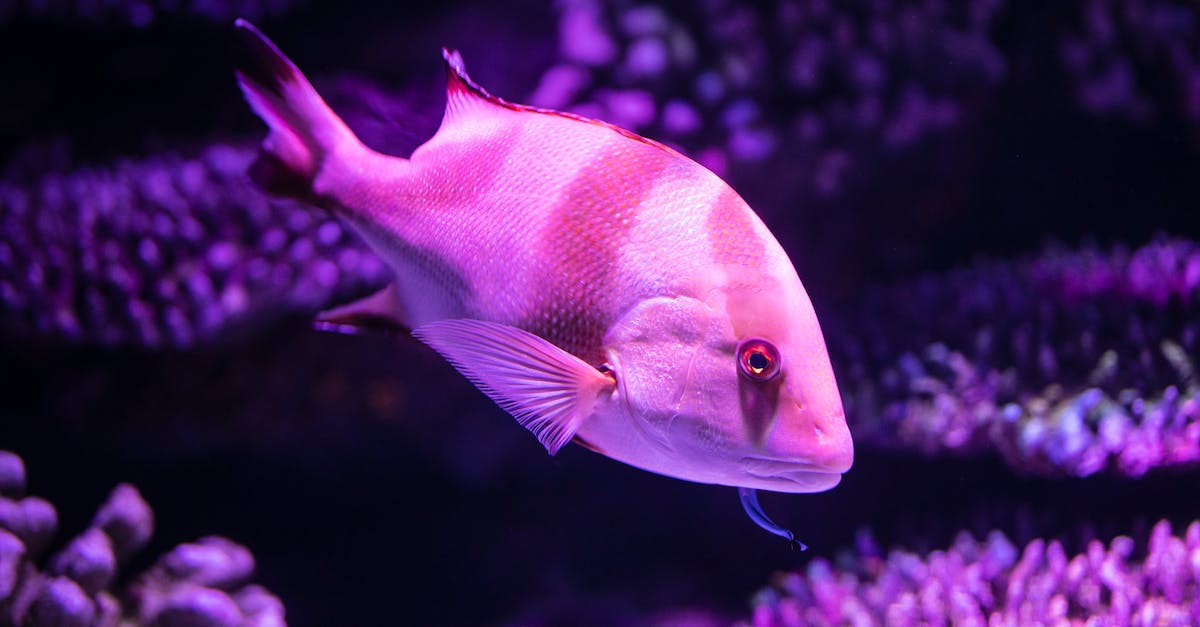Business
Mastering the Art of Introducing Fish to Your Tank: Essential Tips for a Healthy Aquatic Home
Learn how to introduce fish to your tank and keep your aquatic friends healthy! This article explains the step-by-step process of acclimating new fish and provides valuable insights on monitoring and maintaining water parameters for their well-being. Don’t miss out on creating a stable and ideal environment for your fishy companions!
Published
1 year agoon

Are you a new fish owner looking to add some vibrant aquatic life to your tank? Well, you’ve come to the right place! In this article, I’ll be sharing my expert tips on how to introduce fish to your tank in a stress-free and successful manner. Whether you’re a seasoned aquarium enthusiast or a beginner, these tried-and-true methods will ensure that your new fish settle in comfortably and thrive in their new aquatic home. So, let’s dive in and discover the secrets to a smooth and seamless fish introduction process!
When it comes to introducing fish to your tank, it’s important to remember that a gradual approach is key. Rushing the process can lead to unnecessary stress for both your new fish and the existing tank inhabitants. In this article, I’ll guide you through the step-by-step process of acclimating your fish to their new environment, from preparing the tank to monitoring water parameters. By following these simple yet effective techniques, you’ll be able to create a harmonious and healthy ecosystem for your aquatic friends.
So, if you’re ready to embark on this exciting journey of introducing fish to your tank, let’s get started! In the next section, I’ll walk you through the essential preparations you need to make before bringing home your new finned companions. Get ready to create a thriving underwater paradise that will leave both you and your fish in awe.
Understanding the Importance of a Gradual Approach
When it comes to introducing fish to a new tank, taking a gradual approach is key. Rushing the process can lead to stress, shock, and even death for the fish. By slowly acclimating them to their new environment, you greatly increase their chances of not only surviving but thriving in their new home.
Here are a few reasons why a gradual approach is so important:
- Minimize Stress: Fish, like any living creature, can become stressed when subjected to sudden changes. Introducing them slowly allows them to adjust to the new water conditions, temperature, and overall environment without feeling overwhelmed.
- Prevent Shock: Fish are highly sensitive to temperature variations. Sudden changes can put their delicate internal systems into shock, which can be fatal. By acclimating them gradually, you give them time to adapt to the new water temperature and pH levels. This helps to maintain their health and well-being.
- Promote Fish Behavior Observation: Taking a gradual approach also provides an opportunity for you to observe the behavior of the new fish. This way, you can spot any signs of illness, stress, or compatibility issues with other tank inhabitants. Being proactive in monitoring their behavior allows you to intervene early and address any potential problems.
So, how do you go about introducing fish to your tank in a gradual manner? Stay tuned for the next section where I’ll guide you through the step-by-step process of acclimating your fish to their new environment. Remember, patience is key when it comes to providing a stress-free and successful transition for your new aquatic friends.
Preparing the Tank for New Fish
When introducing fish to a new tank, it’s essential to ensure that the tank is properly prepared to provide a suitable and comfortable environment for the fish. Taking the time to set up the tank correctly can greatly increase the chances of a successful introduction and minimize stress for both the fish and the tank owner.
Here are a few steps I follow to prepare the tank for new fish:
- Clean the Tank: Before introducing any new fish, it’s crucial to clean the tank thoroughly. Start by removing any debris, uneaten food, or dead plants from the tank. Use a gentle sponge or algae scraper to clean the glass and ornaments. Avoid using soap or harsh chemicals, as they can be toxic to fish. Rinse everything with warm water to ensure there are no residue left.
- Check the Water Parameters: Proper water quality is vital for the health of the fish. Test for ammonia, nitrite, nitrate, and pH levels to ensure they are within the acceptable range for the specific type of fish you plan to introduce. Use a reliable water testing kit for accurate results.
- Temperature and Heating: Maintaining the right temperature in the tank is crucial for the well-being of the fish. Install a reliable aquarium heater that can maintain a consistent temperature. Research the temperature requirements of the fish species you plan to introduce and adjust the heater accordingly.
- Aquarium Salt (If Required): Some fish species require a small amount of aquarium salt in their water to mimic their natural habitat. If your chosen fish species benefits from aquarium salt, add the appropriate amount to the tank and dissolve it completely before introducing the fish.
- Aquarium Decorations: Consider the preferences of the fish species you plan to introduce when selecting aquarium decorations. Some fish species prefer hiding places, while others enjoy open spaces for swimming. Add appropriate plants, rocks, and caves to create a comfortable and natural environment for the fish.
Choosing the Right Fish for Your Tank
When it comes to adding new fish to your tank, choosing the right fish is key. It’s important to match the fish to the specific tank parameters and to consider their compatibility with existing tank inhabitants. Here are a few things to keep in mind when selecting fish for your tank:
- Tank Size: It’s essential to consider the size of your tank when choosing fish. Each fish species requires a certain amount of space to swim and thrive. Overcrowding can lead to stressed and unhealthy fish. Research the adult size of the fish you want to add and make sure your tank can accommodate them.
- Water Parameters: Different fish have different water parameter requirements. Some fish prefer warm water while others thrive in cooler temperatures. Check the ideal temperature, pH level, and water hardness for the fish species you are interested in. Ensure that your tank’s water conditions can support the specific needs of the fish.
- Social Behavior: Fish have varying social behaviors, some being solitary while others are more social or territorial. It’s important to consider the social nature of the fish you want to introduce to your tank, especially if you already have fish in the tank. Some species may be aggressive towards others, leading to conflicts and stress. Research the compatibility of the fish species and aim for a balanced community.
- Feeding Habits: Another important factor to consider is the feeding habits of the fish. Some fish are omnivorous, eating both plants and small insects, while others are herbivorous or carnivorous. Ensure that the food you provide is suitable for the new fish species. Avoid introducing fish that have drastically different feeding habits from the existing tank inhabitants, as it may lead to competition for food and malnutrition.
By taking these factors into account, you can select the right fish for your tank, ensuring a harmonious and healthy aquatic community. Remember, a gradual approach and careful consideration of compatibility are essential for successfully introducing new fish without disrupting the balance of your tank.
Acclimating Your Fish to the Tank
When bringing new fish into your tank, it’s important to acclimate them properly to ensure their health and well-being. Acclimation is the process of slowly introducing the fish to the new environment, allowing them to adjust to the water conditions and temperature of your tank. This gradual approach helps reduce stress and increases the chances of a successful transition for your new aquatic residents.
Here are a few important steps to follow when acclimating your fish to the tank:
- Float the Bag: When you first bring your new fish home, before opening the bag, you should float it in the tank water for about 15 to 20 minutes. This allows the temperature of the water inside the bag to gradually adjust to that of the tank, avoiding any sudden temperature shocks.
- Drip Acclimation: After floating the bag, you can proceed with the drip acclimation method. To do this, open the bag and use a clean airline tubing or a drip acclimation kit to create a siphon. Start a slow and steady drip from your tank into the bag. The goal of this method is to gradually mix the water in the bag with the water from your tank over a period of time, typically about an hour.
- Monitor the Parameters: While the drip acclimation is in progress, it’s crucial to monitor the temperature and other water parameters in your tank. Make sure the temperature, pH, and ammonia levels are suitable for the new fish. Rapid changes in these parameters can be harmful to the fish, so it’s important to maintain stable conditions.
- Transfer the Fish: Once the acclimation process is complete, it’s time to carefully transfer the fish into the tank. Gently scoop the fish out of the bag with a net or use a bucket if the fish is too large. Avoid transferring any water from the bag into the tank, as it may contain harmful substances or parasites.
Remember, acclimating your fish to the tank is a crucial step in ensuring their well-being. By following a gradual approach and monitoring the water parameters, you can help reduce stress and increase the chances of a successful transition for your new fish.
Monitoring and Maintaining Water Parameters
Once you have successfully acclimated your new fish to the tank, it’s crucial to regularly monitor and maintain the water parameters to ensure their well-being. Fish are extremely sensitive to changes in water conditions, and unstable parameters can lead to stress, illness, and even death. By keeping a close eye on the following key parameters, you can create a healthy and stable environment for your aquatic friends:
- Temperature: Fish are ectothermic creatures, meaning their body temperature depends on the surrounding environment. Maintain a stable water temperature within the ideal range for your particular fish species. Use a reliable aquarium thermometer to regularly monitor the temperature. Sudden changes in temperature can be detrimental to the health of your fish, so it’s important to prevent any fluctuations.
- pH Level: Different fish species have different preferred pH ranges. It’s crucial to determine the optimal pH level for your specific fish and strive to maintain it. Regularly test the water using a pH kit to ensure that it remains within the desired range. If necessary, make adjustments using pH buffers or additives to keep the pH stable and suitable for your fish.
- Ammonia, Nitrite, and Nitrate Levels: Ammonia, nitrite, and nitrate are byproducts of fish waste and decaying organic matter. These compounds can be highly toxic if they accumulate in high concentrations. Regularly test the water for ammonia, nitrite, and nitrate levels using appropriate test kits. Ideally, ammonia and nitrite should be undetectable, while nitrate levels should be kept below 20-40 ppm (parts per million).
- Oxygen Levels: Fish require oxygen to survive, and the level of dissolved oxygen in the water is crucial. Use an aquarium air pump or other oxygenation devices to ensure that there is an adequate supply of oxygen in the tank. Monitor any signs of oxygen depletion, such as fish gasping at the water’s surface, and take immediate action to rectify the situation.
- Water Hardness: Some fish species have specific requirements when it comes to water hardness. Test the water hardness regularly using appropriate test kits and adjust it if necessary. This will help maintain the ideal conditions for your fish and promote their overall health and well-being.
Conclusion
Introducing new fish to your tank requires careful consideration and preparation. By following the steps outlined in this article, you can ensure a smooth and successful transition for your aquatic friends.
First, it’s important to acclimate the fish to the temperature and water conditions of the tank. This helps them adjust gradually and reduces the risk of stress and shock. Remember to take your time during this process and observe the fish closely for any signs of distress.
Next, provide ample hiding places and territories for the new fish to establish themselves in the tank. This helps reduce aggression and promotes a harmonious environment for all the inhabitants.
Finally, monitoring and maintaining water parameters is crucial for the well-being of your fish. Regularly check the temperature, pH level, ammonia, nitrite, nitrate levels, oxygen levels, and water hardness to ensure a healthy and stable environment.
By implementing these practices, you can create a thriving and vibrant aquarium that provides a safe and comfortable home for your fish. Happy fishkeeping!
Frequently Asked Questions
Q: Why is it important to monitor water parameters in a fish tank?
Regularly monitoring water parameters in a fish tank is crucial to maintain a healthy environment for the fish. By monitoring temperature, pH level, ammonia, nitrite, nitrate levels, oxygen levels, and water hardness, you can ensure that the water conditions are suitable for the fish species. This helps prevent stress, disease, and other health issues, ensuring the well-being of your fish.
Q: How often should I monitor water parameters in my fish tank?
It is recommended to monitor water parameters in your fish tank at least once a week. However, if you have recently introduced new fish or made changes to the tank setup, it is advisable to monitor daily or every other day. This frequency allows you to promptly address any issues that may arise and take appropriate actions to maintain optimal water conditions.
Q: How can I monitor water parameters in my fish tank?
To monitor water parameters in your fish tank, you can use various tools and test kits. These may include a thermometer for temperature, pH test kits, ammonia, nitrite, and nitrate test kits, oxygen test kits, and water hardness test kits. Follow the instructions provided with each test kit and use them to measure the respective water parameters accurately.
Q: What are the ideal ranges for water parameters in a fish tank?
The ideal ranges for water parameters in a fish tank can vary depending on the fish species. However, as a general guideline, the recommended ranges are: temperature between 74-82°F (23-28°C), pH level between 6.5-8.2, ammonia level at 0 ppm, nitrite level at 0 ppm, nitrate level below 40 ppm, dissolved oxygen level above 5 mg/L, and water hardness suitable for the specific fish species.
Q: How can I maintain stable water parameters in my fish tank?
To maintain stable water parameters in your fish tank, it is important to implement proper aquarium maintenance practices. This includes regular water changes, keeping the tank clean, avoiding overfeeding, and using appropriate filtration and aeration systems. Additionally, acclimate new fish properly before adding them to your tank, as sudden changes in water parameters can cause stress. Regularly monitoring and adjusting water parameters as necessary will help create a stable and healthy environment for your fish.
With over a decade of experience in the tech industry, Priya Sharma is a seasoned software engineer and tech blogger. She holds a Bachelor's degree in Computer Science from the Indian Institute of Technology (IIT) and has been a key contributor to cutting-edge projects in artificial intelligence and software development.

You may like
Mobility Scooter


Sideways Market: Navigating the Fluctuating Trends
Understanding Market Volatility Market volatility refers to the degree of variability in the price of a financial instrument within a...


Enhance Your iPhone with Adorable Cute Wallpapers
Looking to jazz up your iPhone screen with some cuteness? Discover the impact of adorable wallpapers on your device's look...


Glow Berry Prime: The Science Behind its Skincare Revival
Discover the transformative power of Glow Berry Prime in skincare with its potent blend of 20% Vitamin C, 2% Hyaluronic...


Glov Beauty: Eco-Friendly Products Review | Glov Beauty Reviews
Discover Glov Beauty's eco-friendly products like the Glov On-The-Go set with 500+ uses and the gentle exfoliation offered by the...


Unlocking Drake’s FPS Lyrics: How Gaming Influences His Music
Discover how Drake's lyrics in the first-person shooter-inspired track "War" reflect the influence of FPS games on his music. With...


Defeating a Fire-Breathing Dragon: Strategies for Mage Survival
Prepare yourself for an intense battle as we explore how to face a dragon capable of reaching temperatures over 2000°F....


Exploring Student Life at Glitties Eckerd College
Discover the dynamic student experience at Glitties Eckerd College with a plethora of club options, competitive sports, and community service...


Discover Success Stories with Money6x Real Estate Strategy
Discover the lucrative world of real estate investing with Money6x strategy! Uncover real-life success stories of investors achieving impressive 8-12%...


Get an Inside Look at Julion Alvarez’s 2024 USA Tour
Discover the meticulous planning behind Julion Alvarez's 2024 USA tour! Dive into the world of setlist curation, choreography design, and...


Enhancing Connections through Diversity & Active Listening
Learn how treating peers with empathy and actively listening can enhance relationships and boost innovation. The article emphasizes the significance...